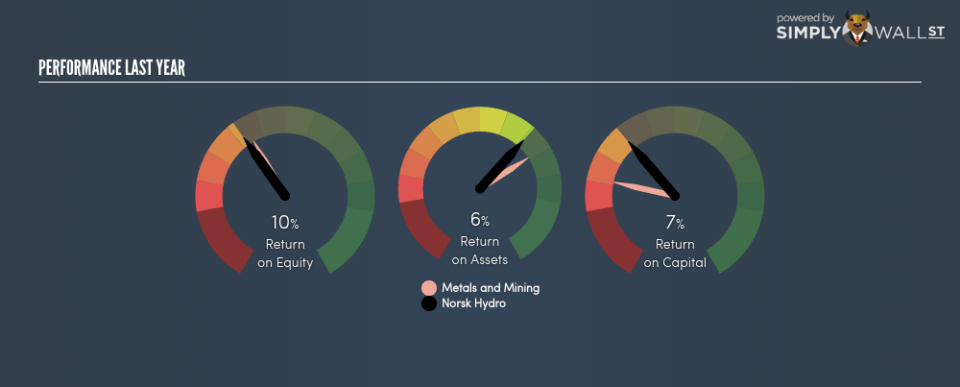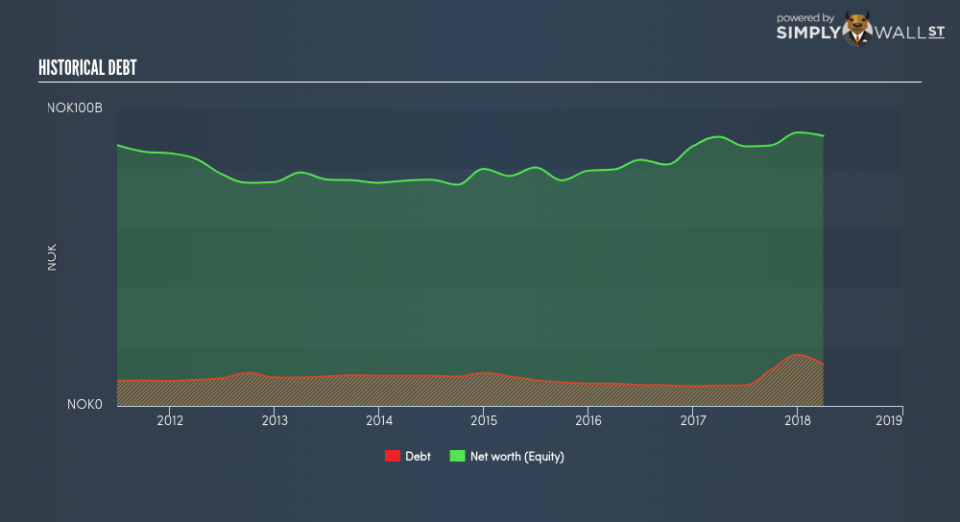Why Norsk Hydro ASA (OB:NHY) May Not Be As Efficient As Its Industry

I am writing today to help inform people who are new to the stock market and looking to gauge the potential return on investment in Norsk Hydro ASA (OB:NHY).
Norsk Hydro ASA (OB:NHY) generated a below-average return on equity of 10.34% in the past 12 months, while its industry returned 11.12%. An investor may attribute an inferior ROE to a relatively inefficient performance, and whilst this can often be the case, knowing the nuts and bolts of the ROE calculation may change that perspective and give you a deeper insight into NHY’s past performance. Today I will look at how components such as financial leverage can influence ROE which may impact the sustainability of NHY’s returns. Check out our latest analysis for Norsk Hydro
Breaking down Return on Equity
Return on Equity (ROE) weighs Norsk Hydro’s profit against the level of its shareholders’ equity. For example, if the company invests NOK1 in the form of equity, it will generate NOK0.10 in earnings from this. While a higher ROE is preferred in most cases, there are several other factors we should consider before drawing any conclusions.
Return on Equity = Net Profit ÷ Shareholders Equity
ROE is assessed against cost of equity, which is measured using the Capital Asset Pricing Model (CAPM) – but let’s not dive into the details of that today. For now, let’s just look at the cost of equity number for Norsk Hydro, which is 10.98%. This means Norsk Hydro’s returns actually do not cover its own cost of equity, with a discrepancy of -0.64%. This isn’t sustainable as it implies, very simply, that the company pays more for its capital than what it generates in return. ROE can be split up into three useful ratios: net profit margin, asset turnover, and financial leverage. This is called the Dupont Formula:
Dupont Formula
ROE = profit margin × asset turnover × financial leverage
ROE = (annual net profit ÷ sales) × (sales ÷ assets) × (assets ÷ shareholders’ equity)
ROE = annual net profit ÷ shareholders’ equity
Basically, profit margin measures how much of revenue trickles down into earnings which illustrates how efficient the business is with its cost management. Asset turnover shows how much revenue Norsk Hydro can generate with its current asset base. Finally, financial leverage will be our main focus today. It shows how much of assets are funded by equity and can show how sustainable the company’s capital structure is. Since ROE can be inflated by excessive debt, we need to examine Norsk Hydro’s debt-to-equity level. At 15.38%, Norsk Hydro’s debt-to-equity ratio appears low and indicates that Norsk Hydro still has room to increase leverage and grow its profits.
Next Steps:
While ROE is a relatively simple calculation, it can be broken down into different ratios, each telling a different story about the strengths and weaknesses of a company. Norsk Hydro’s below-industry ROE is disappointing, furthermore, its returns were not even high enough to cover its own cost of equity. However, ROE is not likely to be inflated by excessive debt funding, giving shareholders more conviction in the sustainability of returns, which has headroom to increase further. ROE is a helpful signal, but it is definitely not sufficient on its own to make an investment decision.
For Norsk Hydro, I’ve compiled three important factors you should further research:
Financial Health: Does it have a healthy balance sheet? Take a look at our free balance sheet analysis with six simple checks on key factors like leverage and risk.
Valuation: What is Norsk Hydro worth today? Is the stock undervalued, even when its growth outlook is factored into its intrinsic value? The intrinsic value infographic in our free research report helps visualize whether Norsk Hydro is currently mispriced by the market.
Other High-Growth Alternatives : Are there other high-growth stocks you could be holding instead of Norsk Hydro? Explore our interactive list of stocks with large growth potential to get an idea of what else is out there you may be missing!
To help readers see pass the short term volatility of the financial market, we aim to bring you a long-term focused research analysis purely driven by fundamental data. Note that our analysis does not factor in the latest price sensitive company announcements.
The author is an independent contributor and at the time of publication had no position in the stocks mentioned.


